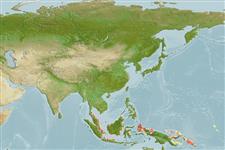Common names from other countries
>
Blenniiformes (Blennies) >
Blenniidae (Combtooth blennies) > Salariinae
Etymology: Paralticus: Greek, para = near + Latin, altus = nutritious (Ref. 45335).
More on author: Bleeker.
Environment: milieu / climate zone / depth range / distribution range
Ecologia
marinhas associadas(os) a recifes; intervalo de profundidade 0 - 1 m (Ref. 90102). Tropical; 32°N - 15°S
Western Central Pacific: known only from northeastern Sabah east to western New Guinea at Biak Island and Geelvink [=Sarera or Cenderawasih] Bay.
Tamanho / Peso / Idade
Maturity: Lm ? range ? - ? cm
Max length : 16.0 cm TL macho/indeterminado; (Ref. 48636); 10.6 cm SL (female)
Descrição suscinta
Morfologia | Morfometria
Espinhos dorsais (total): 12 - 13; Raios dorsais (total): 17-20; Espinhos anais 2; Raios anais : 18 - 20. Large bushy tentacles above the eyes and the broad rounded snout (Ref. 48636).
In sheltered bays and lagoons, on rocky reefs and commonly found under jetties on the pylons near the surface (Ref. 48636); also found along semi-exposed rocky shorelines (Ref. 1602). Also found in mangroves and on shoreline reefs. Solitary (Ref. 90102) but also occurs in small groups (Ref. 48636). Oviparous (Ref. 205). Eggs are demersal and adhesive (Ref. 205).
Ciclo de vida ou comportamento de acasalamento
Maturidade | Reprodução | Desova | Ovos | Fecundidade | Larvas
Oviparous, distinct pairing (Ref. 205).
Springer, V.G. and J.T. Williams, 1994. The Indo-West Pacific blenniid fish genus Istiblennius reappraised: a revision of Istiblennius, Blenniella, and Paralticus, new genus. Smithson. Contrib. Zool. 565:1-193. (Ref. 9962)
Status na Lista Vermelha da UICN (Ref. 130435)
CITES (Ref. 128078)
Not Evaluated
Ameaça para os humanos
Harmless
Uso pelos humanos
Mais informação
Idade/TamanhoCrescimentoPeso-comprimentoComprimento-comprimentoFrequências de comprimentoMorfometriaMorfologiaLarvasDinâmica larvalRecrutamentoAbundância
ReferênciasAquaculturaPerfil para aquaculturaEstirpesGenéticaElectrophoresesHereditariedadeDoençasProcessamentoConversão de massa
ColaboradoresFotosStamps, Coins Misc.SonsCiguateraVelocidadeTipo de nataçãoÁrea branquialOtólitosCérebrosVisão
Ferramentas
Relatórios especiais
Baixar XML
Fontes da internet
Estimates based on models
Preferred temperature (Ref.
115969): 28.7 - 29.2, mean 28.9 (based on 154 cells).
Índice de diversidade filogenética (Ref.
82804): PD
50 = 1.0000 [Uniqueness, from 0.5 = low to 2.0 = high].
Bayesian length-weight: a=0.01072 (0.00480 - 0.02393), b=3.01 (2.82 - 3.20), in cm Total Length, based on LWR estimates for this (Sub)family-body shape (Ref.
93245).
Resiliência (Ref.
120179): Elevada, tempo mínimo de duplicação da população menor que 15 meses (Preliminary K or Fecundity.).
Fishing Vulnerability (Ref.
59153): Low vulnerability (10 of 100).
